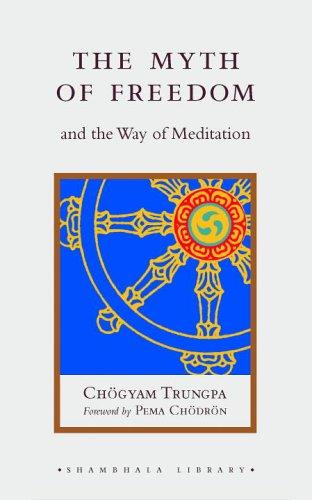Review of 'The Myth of Freedom and the Way of Meditation (Shambhala Pocket Classics)' on 'Goodreads'
3 stars
I read this many years ago as part of a class in Buddhism that I took as a college sophomore, one of three textbooks in the class. The first textbook was a guide to a reader knowing nothing about the religion, and the third one was an abstruse volume by the Tibetan teacher Longchempa which no one I knew could make teads or tails of. Appropriately, this book of lectures was situated in between, with the assumption that the audience knew something of the basic teachings of Hinayana and Mahayana Buddhism but wanted to know something about the Vajrayana teachings from Tibet. The early chapters, especially, are given at a level which isn't too hard too absorb at this level, where he takes pains to dispel some of the misconceptions about meditation and religious practice that someone serious about practicing the discipline would find useful. Particularly striking are his narrative …
I read this many years ago as part of a class in Buddhism that I took as a college sophomore, one of three textbooks in the class. The first textbook was a guide to a reader knowing nothing about the religion, and the third one was an abstruse volume by the Tibetan teacher Longchempa which no one I knew could make teads or tails of. Appropriately, this book of lectures was situated in between, with the assumption that the audience knew something of the basic teachings of Hinayana and Mahayana Buddhism but wanted to know something about the Vajrayana teachings from Tibet. The early chapters, especially, are given at a level which isn't too hard too absorb at this level, where he takes pains to dispel some of the misconceptions about meditation and religious practice that someone serious about practicing the discipline would find useful. Particularly striking are his narrative digressions where he expands on a point by conjuring up some imagined conflict in everyday life a person might be expected to encounter, contrasting the naive view with the enlightened response.
These are frequently humorous and just the kind of thing a teacher would use to make a memorable impression in someone they are guiding. For someone who is outside the religion, who might mainly be interested in comparing different systems of belief rather than wondering how best they might adopt Tibetan-style Buddhism into their own life, this might not be the best guide, because the intention is to give instruction rather than formulate a coherent account of the different aspects of Buddhist tradition from the ground up. The chapters are organized with titles that are signposts to outsiders, but the full meaning and context of each one is largely assumed. So I remember reading this with a sense of being overwhelmed the first time, while coming back to it with my memories of what I learned back then was somewhat less daunting.
The beauty and austerity of the Buddhist way at its highest levels is apparent in the rinpoche's words.
I listened to this as an audiobook, which I think made it easier to understand in some ways, but harder when it came to the long list of paramitas which always tends to blend together in my mind. This is where I'd like to have an illustration with the Sanskrit names and their various qualities listed instead of having to retain them all in memory.

